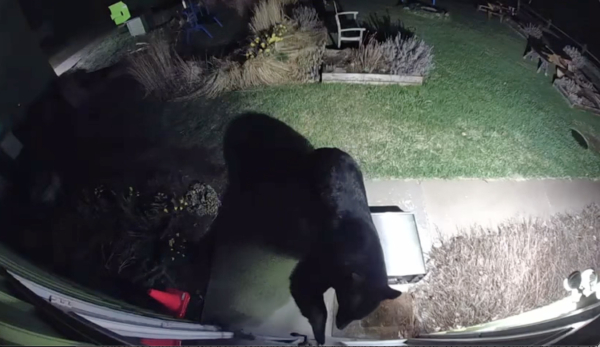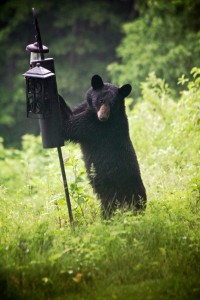Bear crazy: DNR study seeks answers to human-bear conflict
Photo: Tim Mulherin poses with a trapped, sedated (alive and healthy) adult black bear in the Baldwin Management Area in July. The DNR is collaborating with Utah State University researchers on the Baldwin Bear Project to study bear movement, density, human-bear conflict and the question of coexistence.
By Tim Mulherin
Sun contributor
In September 2023, I visited the Upper Peninsula with my brother Chris for a few days of hiking at Pictured Rocks National Lakeshore. On the first morning of our stay in Grand Marais, he went for an early run, notably not wearing his glasses. Returning about an hour later, he breathlessly spoke of seeing “a large black animal” that intersected his path, perhaps 15 yards away, loping toward Lake Superior across Everett Avenue. Curious, Chris asked a man walking his dog what it might have been. The eyewitness laughed, responding, “That, my friend, was a bear.” Mr. Magoo was astonished by the revelation.
With so many reports of bear sightings in northern Michigan—the Michigan Department of Natural Resources estimates there are 2,000 black bears living here, with more than 10,000 in the Upper Peninsula—I had yet to observe one Up North. (Even though my optometrist says my vision is excellent.)
For the past several years, “Bear Crossing” signs have been posted in May near the Cedar Hardware store on South Kasson Street, just a few miles from our home. Our friends Phil and Mary Nachazel, who live about a mile from us on their 12-acre hillside property, see bears most every spring, when these opportunistic omnivores prowl their land and are drawn to their bird feeders. It’s a reminder that newly awakened bears are ravenous from their long winter’s nap and are hunting for an easy meal, often offered unwittingly by humans.
On multiple occasions, I’ve come across fresh bear scat on hiking trails at Sleeping Bear Dunes National Lakeshore. Three years ago, I picked up the pieces of our battered charcoal grill scattered about by an apparently disappointed bear. Yet, no bear sightings for me in northern Michigan—whether in beautiful downtown Cedar, in our neighborhood near the Sugar Loaf Golf Course, or in the wild—despite the many excited reports of sightings posted on local Facebook pages. Nonetheless, I hoped that someday my time would come.
I did, however, encounter a black bear in the early ’60s when I was a five-year-old boy. I was with my Grandpa Mulherin picking berries in the Pocono Mountains near Scranton, Pa., where I grew up. We saw it; it saw us; and that was that. Grandpa, accustomed to seeing black bears on his post-Sunday morning Mass hikes, made sure we kept a respectable distance away. But he certainly wasn’t scared of the bear. And because of that, neither was I.

A screenshot of a surveillance video showing the black bear, just before it opened the back door to Grocer’s Daughter Chocolate on April 16, 2024.
Perhaps because of that decades old childhood memory, as part of my research for a book on Michigan’s wildlife, I selected the black bear as a subject of interest. People are generally fascinated by Ursus americanus, as local news reports attest. For example, whenever one is seen wandering around outside the Grand Traverse Mall, or the Empire “sugar bear” commits breaking and entering, as it did last April at Grocer’s Daughter Chocolate Shop, it’s practically breaking news. What’s more, as highlighted in the May 16 edition of this newspaper, we humans are finding it increasingly challenging to coexist with black bears as our encroachment upon their habitat continues unabated.
Last spring, Cody Norton, a wildlife biologist with the Michigan Department of Natural Resources (DNR), connected me with researchers from Utah State University’s S.J. & Jessie E. Quinney College of Natural Resources: graduate student Sara Fischer and Ph.D. candidate Taylor Peltier. The DNR is collaborating with them on a study called the Baldwin Bear Project. As stated on its Facebook page, the project “aims to understand the ecology and human dimensions of black bears in Michigan,” with an emphasis on examining the growing population in northern lower Michigan. Fischer’s focus is on bear movement and density; Peltier is exploring human-bear interactions and public perception. Peltier explains that the project’s overall goal is to collect data to “inform best practices and management for limiting human-black bear conflict.”

Michael Collier photographed this black bear visiting his bird feeder at his home on Miller Hill, east of the Glen Lakes, in June 2014.
On a mid-July evening I spoke with Peltier by phone, and she invited me to tagalong with the research team when they captured their next black bear. I could barely contain my excitement. Sixteen traps had been set in three different areas in the Baldwin Management Area, so I anticipated hearing from her soon. She called the following morning.
“We have a bear. Can you be here in an hour? It’s near Thompsonville.” They needed to remove the bear from the trap as soon as possible for its safety, especially given July’s heat wave. I hit the door running.
The Google Map coordinates Peltier provided led me to the rendezvous point, directing me down a bumpy two-track with gaping water-filled holes. Minutes later, a caravan of three DNR pickup trucks appeared. I parked my SUV at a trail gate, hopped aboard a Ford F-250, and we jounced our way to the trap, about a mile away.
We pulled up near a large khaki-colored metal tube set in the middle of a hunting trail. The red-lettered sign on the closed door warned CAUTION: BEAR TRAP. Norton and a wildlife technician carefully sedated the bear, and the rest of us waited nearby for the anesthesia to take full effect. Norton smiled as he said, “We have a good-sized bear.” And it was: all 281.5 pounds of adult male black bear.
The bear had been lured by smoke and vanilla scents applied along the trail and seduced by donuts and marshmallows inside the trap. This struck me as something out of the Yogi Bear ’60s cartoon set in fictional Jellystone Park. But it works like a charm.
Whispering so as not to disturb the bear, Peltier shared more about her research objectives. “My interest is in what are people’s perceptions of bears, what conflict is being reported to the DNR and not being reported to the DNR, and is the DNR doing a good job of providing the public the necessary tools that they need to stay bear safe.” Her work will ultimately address the question of how humans can successfully coexist with bears. “There’s this interesting dynamic between how people can be so afraid and polarized by bears,” she commented, “and yet, they’re like the mascot of the North Woods.”
As part of her job, Baylee Draper, a DNR wildlife technician who works out of the Traverse City Customer Service Center and who served as a team member on the bear capture and medical evaluation, fields calls on bear complaints in the Grand Traverse region. Draper says, “During the spring and summer months we tend to get the majority of our nuisance bear calls because they come out of hibernation and are now moving around looking for food, kicking out yearlings, and raising new young.” In the spring, she added, such calls come in almost daily.
Among other recommendations, Draper diplomatically advises callers to take down bird feeders until the nuisance bear stops frequenting the area, keep trash cans inside garages, and not to leave pet food outside. She mentioned that some complainants want the DNR to “get this bear out of my yard.” With the influx of people who relocated to the region during the pandemic and continue to, much of it driven by the ability to work remotely, bear complaints are inevitable. Many newcomers are from urban areas and have never encountered a wild black bear. The first time can be a real eye-opener.
Conservation Officer Rich Stowe, who’s assigned to District 4, Area 1—which includes Leelanau, Grand Traverse, Benzie, and Wexford counties—once covered Presque Isle County in northeast lower Michigan. In an earlier conversation, he called it “a very bear rich area of the state.” Stowe says that people there are generally used to bears, so complaints are few. He pointed out that when it comes to the black bear population in northern Michigan, there is “carrying capacity by habitat, and then there’s social carrying capacity, which we may have exceeded in this region,” meaning, “what people will tolerate.”
Male bears’ home ranges can be “upwards of 30 square miles,” Fischer says, with females typically ranging from five to 20 miles. Indeed, these large mammals need their space. Urbanized bears sharing territory with thousands and thousands of people, such as in Grand Traverse County, tend not to do well, as they become habituated to foraging for food often carelessly left out by humans. Chances are they then get labeled as nuisance bears and must be relocated or, tragically, even euthanized.
Our group discussion ended promptly when Norton and the DNR team removed the unconscious bear from the trap and immediately went to work. They weighed and measured it: length,182 centimeters; chest girth, 112.5 cm; neck circumference, 68.8 cm. Every five minutes the bear’s TPR—temperature, pulse, and respiration—got checked. Norton and another brawny DNR employee worked diligently to fit a GPS tracking collar on the bear, allowing room for the animal’s growth while keeping it snug enough to prevent the bear from slipping out of the collar. The tracking device records the bear’s position 48 times per day, and the data is available to the researchers twice daily.
A small ear tag was applied as well to identify the bear. Blood and hair samples were taken, to be sent to a lab to detect any disease and determine the bear’s age. By all appearances, this was a very healthy bear.
Once the medical workup concluded, Peltier invited me to pose with the sleeping bear. I asked permission to touch it: “Of course.” Somewhat nervously, I placed my hand on the anesthetized bear’s side. When I viewed the pic later, childlike awe was written all over my photographed face. I felt privileged to be in the presence of makwa, the Anishinaabe word for bear. (Mukwa dodem—bear clan—is the largest of the seven major clans, whose members are considered protectors of their community.)
I wondered if this bear would make it to 10 years, the average black bear lifespan in the wild, or if it would be harvested by one of the approximately 400 lottery-selected license holders for the DNR’s Baldwin Bear Management Unit this hunting season (Sept. 14-24 and Oct. 4-10).
There are other risks for Michigan’s black bears, like being struck and disabled or killed by a vehicle while crossing a road. Or, as noted earlier, becoming designated as a nuisance bear, to be trapped and removed from its home range to prevent it from distressing homeowners. Living in proximity to humans is indeed risky business for all wildlife.
While driving back to Cedar after my day in the woods with the Baldwin Bear Project researchers and that formidable specimen, I pondered what recommendations the study would make. (Of note, the research team trapped and assessed 13 bears this summer, shy of the goal of 20, with three bears slipping their collars.) The vibrant black bear population in northern Michigan is a good ecological sign. Yet the rising human population is a threat to the ongoing success of black bears in the region. The answer most likely lies in educating the public about the importance of the bears’ place among us. Perhaps belonging shouldn’t be an argument that we humans always win.
Tim Mulherin’s new book, This Magnetic North: Candid Conversations on a Changing Northern Michigan, will be published by Michigan State University Press in June 2025.











